28 books about Automatic control
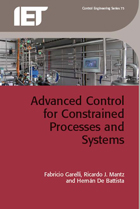
Advanced Control for Constrained Processes and Systems
Fabricio Garelli
The Institution of Engineering and Technology, 2011
This book provides a unified, practically-oriented treatment to many constrained control paradigms. Recently proposed control strategies are unified in a generalised framework to deal with different kinds of constraints. The book's solutions are based on reference conditioning ideas implemented by means of supervisory loops, and they are complementary to any other control technique used for the main control loop. Although design simplicity is a book priority, the use of well established sliding mode concepts for theoretical analysis make it also rigorous and self-contained.
[more]

Applied Control Theory
J.R. Leigh
The Institution of Engineering and Technology, 1987
'To the surprise of some undergraduates, processes do not carry labels marking their variables nor, alas, are they conveniently classified into linear, nonlinear, stochastic, etc., categories. The ability to come to terms with this situation is a prerequisite for anyone proposing to succeed in an industrial environment.' This quotation from Chapter 1 characterises the viewpoint of the book, which is concerned with the application of control theory to real problems in their industrial context.
[more]
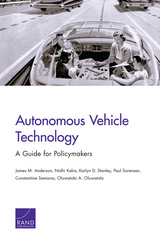
Autonomous Vehicle Technology
A Guide for Policymakers
James M. Anderson
RAND Corporation, 2014
The automotive industry appears close to substantial change engendered by “self-driving” technologies. This technology offers the possibility of significant benefits to social welfare—saving lives; reducing crashes, congestion, fuel consumption, and pollution; increasing mobility for the disabled; and ultimately improving land use. This report is intended as a guide for state and federal policymakers on the many issues that this technology raises.
[more]

Code of Practice for Building Automation and Control Systems
The Institution of Engineering and Technology
The Institution of Engineering and Technology, 2020
Within the modern built environment, advanced engineering systems allow us to go about our daily lives in a relative degree of safety, comfort and security. Often, we do not give too much thought about what is happening behind the scenes.
[more]

Computer Control of Real-Time Processes
S. Bennett
The Institution of Engineering and Technology, 1990
This book provides an introduction to many aspects of computer control. It covers techniques or control algorithm design and tuning of controllers; computer communications; parallel processing; and software design and implementation. The theoretical material is supported by case studies covering power systems control, robot manipulators, liquid natural as vaporisers, batch control of chemical processes; and active control of aircraft.
[more]

Control Engineering Solutions
A practical approach
P. Albertos
The Institution of Engineering and Technology, 1997
This book collects together in one volume a number of control engineering solutions, intended to be representative of solutions applicable to a broad class of control problems, and outlines possible alternative approaches to finding them. This is neither a control theory book nor a handbook of laboratory experiments, although it includes both the basic theory of control and practical laboratory set-ups to illustrate the solutions proposed.
[more]
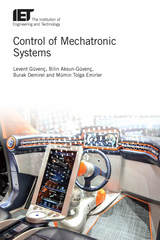
Control of Mechatronic Systems
Levent Güvenç
The Institution of Engineering and Technology, 2017
This book introduces researchers and advanced students with a basic control systems background to an array of control techniques which they can easily implement and use to meet the required performance specifications for their mechatronic applications. It is the result of close to two decades of work of the authors on modeling, simulating and controlling different mechatronic systems from the motion control, automotive control and micro and nano-mechanical systems control areas. The methods presented in the book have all been tested by the authors and a very large group of researchers, who have produced practically implementable controllers with highly successful results.
[more]

Control Theory
J.R. Leigh
The Institution of Engineering and Technology, 2004
Concise highly readable book emphasising the concepts and principles that are prerequisite for understanding both traditional and recent control theory.
[more]
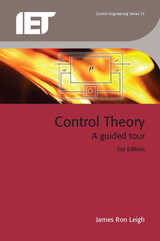
Control Theory
A guided tour
James Ron Leigh
The Institution of Engineering and Technology, 2012
Using clear tutorial examples, this fully updated new edition concentrates on explaining and illustrating the concepts that are at the heart of control theory.
[more]
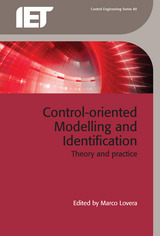
Control-oriented Modelling and Identification
Theory and practice
Marco Lovera
The Institution of Engineering and Technology, 2015
This comprehensive book covers the state-of-the-art in control-oriented modelling and identification techniques. With contributions from leading researchers in the subject, Control-oriented Modelling and Identification: Theory and practice covers the main methods and tools available to develop advanced mathematical models suitable for control system design, including: object-oriented modelling and simulation; projection-based model reduction techniques; integrated modelling and parameter estimation; identification for robust control of complex systems; subspace-based multi-step predictors for predictive control; closed-loop subspace predictive control; structured nonlinear system identification; and linear fractional LPV model identification from local experiments using an H1-based glocal approach.
[more]
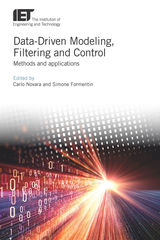
Data-Driven Modeling, Filtering and Control
Methods and applications
Carlo Novara
The Institution of Engineering and Technology, 2019
The scientific research in many engineering fields has been shifting from traditional first-principle-based to data-driven or evidence-based theories. The latter methods may enable better system design, based on more accurate and verifiable information.
[more]

Design of Modern Control Systems
D.J. Bell
The Institution of Engineering and Technology, 1982
This book presents developments in analysis and design techniques for control systems. Included are exciting results for feedback systems using complex variable methods, the important concept of robustness in controller design and the increasingly important topic of decentralized control for large scale systems. These and many other contributions illustrate the great activity and rapid progress which has taken place in the subject over the past few years. Only by bringing these contributions together under one cover can the practising engineer in industry and indeed the engineer in university or polytechnic keep fully informed on the 'state of the art' on a number of different fronts. Application of the theoretical developments and practical aspects of the subject are not forgotten; analysis and design of a nuclear boiler and some direct digital control system design procedures are but two topics discussed in the present book. Several of the chapters are followed by problems on the subject matter and worked solutions to most of these problems are given at the end of the book. This aspect will find favour with many readers since such contributions are often a great help in the understanding of the subject matter.
[more]

Deterministic Control of Uncertain Systems
A.S.I. Zinober
The Institution of Engineering and Technology, 1990
One of the main fields of study in the control of dynamical systems has been the effective control of time-varying systems with uncertain parameters and external disturbances. In contrast to stochastic adaptive controllers with identification algorithms, the deterministic control of uncertain time-varying systems has a fixed nonlinear feedback controller, which operates effectively over a specified magnitude range of a class of system variations. If the variations satisfy certain matching conditions, complete insensitivity to system uncertainties can be achieved. The two main approaches are Variables Structure and Lyapunov control. The contents of this book reflect the research output of many authors. The chapters include material of an introductory nature as well as some of the latest research results. Attention has also been focussed upon some of the main areas of application, which include electric motor drives, robotics and flight control systems. The book should prove useful to control designers, theoreticians and graduate students.
[more]
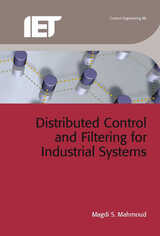
Distributed Control and Filtering for Industrial Systems
Magdi S. Mahmoud
The Institution of Engineering and Technology, 2012
In recent years technological advancements in the design and fabrication of integrated circuits have led to the development of cost effective, low power, thumb-size devices that can be used for sensing/actuating, communication and computing. This trend is enabling a surge of new applications for which pervasive network architectures are being developed. A key feature of these systems is that they are decentralized and communication among different subsystems may be unreliable. From an engineering viewpoint, to ensure correct operation, the theoretical analysis requires a fundamental paradigm shift, as many of the typical assumptions of systems and control theory cease to hold.
[more]
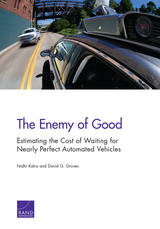
The Enemy of Good
Estimating the Cost of Waiting for Nearly Perfect Automated Vehicles
Nidhi Kalra
RAND Corporation, 2017
How safe should highly automated vehicles (HAVs) be before they are allowed on the roads for consumer use? In this report, RAND researchers use the RAND Model of Automated Vehicle Safety to compare road fatalities over time under a policy that allows HAVs to be deployed when their safety performance is just moderately better than human drivers and a policy that waits to deploy HAVs only once their performance is nearly perfect.
[more]
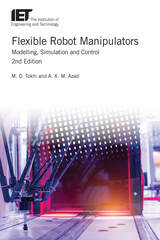
Flexible Robot Manipulators
Modelling, simulation and control
M.O. Tokhi
The Institution of Engineering and Technology, 2017
Industrial automation is driving the development of robot manipulators in various applications, with much of the research effort focussed on flexible manipulators and their advantages compared to their rigid counterparts. This book reports recent advances and new developments in the analysis and control of these robot manipulators.
[more]
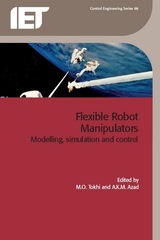
Flexible Robot Manipulators
Modelling, simulation and control
M. Osman Tokhi
The Institution of Engineering and Technology, 2008
The ever increasing utilisation of robotic manipulators for various applications in recent years has been motivated by the requirements and demands of industrial automation. Among these, attention is focused more towards flexible manipulators, due to various advantages they offer compared to their rigid counterparts. Flexural dynamics have constituted the main research challenge in modelling and control of such systems; research activities have accordingly concentrated on the development of methodologies to cope with this.
[more]
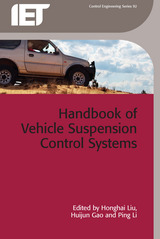
Handbook of Vehicle Suspension Control Systems
Honghai Liu
The Institution of Engineering and Technology, 2013
Handbook of Vehicle Suspension Control Systems surveys the state-of-the-art in advanced suspension control theory and applications. Topics covered include an overview of intelligent vehicle suspension control systems; intelligence-based vehicle active suspension adaptive control systems; robust active control of an integrated suspension system; an interval type-II fuzzy controller for vehicle active suspension systems; active control for actuator uncertain half-car suspension systems; active suspension control with finite frequency approach; fault-tolerant control for uncertain vehicle suspension systems via fuzzy control approach; h-infinity fuzzy control of suspension systems with actuator saturation; design of sliding mode controllers for semi-active suspension systems with magnetorheological dampers; joint design of controller and parameters for active vehicle suspension; an LMI approach to vibration control of vehicle engine-body systems with time delay; and frequency domain analysis and design of nonlinear vehicle suspension systems.
[more]
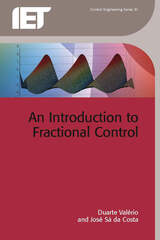
An Introduction to Fractional Control
Duarte Valério
The Institution of Engineering and Technology, 2012
Fractional control techniques provide an effective way to control dynamic behaviours, using fractional differential equations. This can include the control of fractional plants, the control of a plant using a fractional controller, or the control of a plant so that the controlled system will have a fractional behaviour to achieve a performance that would otherwise be hard to come by.
[more]

Knowledge-based Systems for Industrial Control
J. McGhee
The Institution of Engineering and Technology, 1990
Expert and knowledge-based systems have great potential for industrial control systems, particularly in the process industries. Recognising the importance of this emerging area, the Institution of Electrical Engineers organised a Vacation School on the subject, for engineers from industry and academia, at the University of Strathclyde in September 1990.
[more]
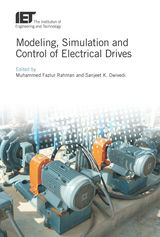
Modeling, Simulation and Control of Electrical Drives
Mohammed Fazlur Rahman
The Institution of Engineering and Technology, 2019
Thanks to advances in power electronics device design, digital signal processing technologies and energy efficient algorithms, ac motors have become the backbone of the power electronics industry. Variable frequency drives (VFD's) together with IE3 and IE4 induction motors, permanent magnet motors, and synchronous reluctance motors have emerged as a new generation of greener high-performance technologies, which offer improvements to process and speed control, product quality, energy consumption and diagnostics analytics.
[more]

Neural Network Applications in Control
G.W. Irwin
The Institution of Engineering and Technology, 1995
Neural networks are an exciting technology of growing importance in real industrial situations, particularly in control and systems. This book aims to give a detailed appreciation of the use of neural nets in these applications; it is aimed particularly at those with a control or systems background who wish to gain an insight into the technology in the context of real applications.
[more]

Polynomial Methods in Optimal Control and Filtering
Kenneth Hunt
The Institution of Engineering and Technology, 1993
This book aims to demonstrate the power and breadth of polynomial methods in control and filtering. Direct polynomial methods have previously received little attention compared with the alternative Wiener-Hopf transfer-function method and the statespace methods which rely on Riccati equations.
[more]

Seeing Like a Rover
How Robots, Teams, and Images Craft Knowledge of Mars
Janet Vertesi
University of Chicago Press, 2015
In the years since the Mars Exploration Rover Spirit and Opportunity first began transmitting images from the surface of Mars, we have become familiar with the harsh, rocky, rusty-red Martian landscape. But those images are much less straightforward than they may seem to a layperson: each one is the result of a complicated set of decisions and processes involving the large team behind the Rovers.
With Seeing Like a Rover, Janet Vertesi takes us behind the scenes to reveal the work that goes into creating our knowledge of Mars. Every photograph that the Rovers take, she shows, must be processed, manipulated, and interpreted—and all that comes after team members negotiate with each other about what they should even be taking photographs of in the first place. Vertesi’s account of the inspiringly successful Rover project reveals science in action, a world where digital processing uncovers scientific truths, where images are used to craft consensus, and where team members develop an uncanny intimacy with the sensory apparatus of a robot that is millions of miles away. Ultimately, Vertesi shows, every image taken by the Mars Rovers is not merely a picture of Mars—it’s a portrait of the whole Rover team, as well.
With Seeing Like a Rover, Janet Vertesi takes us behind the scenes to reveal the work that goes into creating our knowledge of Mars. Every photograph that the Rovers take, she shows, must be processed, manipulated, and interpreted—and all that comes after team members negotiate with each other about what they should even be taking photographs of in the first place. Vertesi’s account of the inspiringly successful Rover project reveals science in action, a world where digital processing uncovers scientific truths, where images are used to craft consensus, and where team members develop an uncanny intimacy with the sensory apparatus of a robot that is millions of miles away. Ultimately, Vertesi shows, every image taken by the Mars Rovers is not merely a picture of Mars—it’s a portrait of the whole Rover team, as well.
[more]

Singular Perturbation Methodology in Control Systems
D.S. Naidu
The Institution of Engineering and Technology, 1988
Many realistic engineering systems are large in dimension and stiff for computation. Their analysis and control require extensive numerical algorithms. The methodology of singular perturbations and time scales (SPTS), crowned with the remedial features of order reduction and stiffness relief is a powerful technique to achieve computational simplicity.
[more]
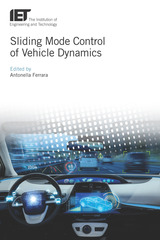
Sliding Mode Control of Vehicle Dynamics
Antonella Ferrara
The Institution of Engineering and Technology, 2017
The control of the longitudinal, lateral and vertical dynamics of two and four-wheeled vehicles, both of conventional type as well as fully-electric, is important not only for general safety of vehicular traffic in general, but also for future automated driving.
[more]
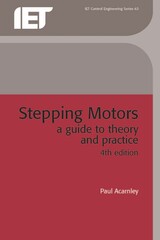
Stepping Motors
A guide to theory and practice
Paul Acarnley
The Institution of Engineering and Technology, 2002
Stepping motor technology is well established and used for motion control, most notably for computer peripherals but also wherever digital control is employed. This book provides an introductory text which will enable the reader to both appreciate the essential characteristics of stepping motor systems and understand how these characteristics are being exploited in the continuing development of new motors, drives and controllers. A basic theoretical approach relating to the more significant aspects of performance is presented, although it is assumed throughout that the reader has no previous experience of electrical machines and is primarily interested in the applications of stepping motors. Paul Acarnley's outstanding reference book is widely known and used, and this, the 4th edition, has been significantly updated to include many new applications that have emerged since the previous edition was published. Coverage includes: drive circuits, accurate load positioning, static torque characteristics, multi-step operation, torque/ speed characteristics, high-speed operation, open-loop control, closed-loop control and microprocessor-based stepping motor systems.
[more]

Symbolic Methods in Control System Analysis and Design
Neil Munro
The Institution of Engineering and Technology, 1999
Symbolic computing has made a significant impact in the field of control engineering. This book, which brings together contributions from leading international experts in the field, provides an up-to-date treatment of various issues in system modelling, analysis, design and synthesis methods.
[more]
READERS
Browse our collection.
PUBLISHERS
See BiblioVault's publisher services.
STUDENT SERVICES
Files for college accessibility offices.
UChicago Accessibility Resources
home | accessibility | search | about | contact us
BiblioVault ® 2001 - 2024
The University of Chicago Press









